#konami digital entertainment
Text
[SBR2] 30% Off! | Wednesday, 11.22.2023
For a limited time on Steam, you can save 30% off when you purchase SUPER BOMBERMAN R 2 right now.

#30% off#aqua bomber#autumn#autumn 2023#autumn sale#black bomber#blue bomber#bomberman#bomberman bros.#female protagonists#green bomber#konami#konami digital entertainment#konami entertainment#konami games#limited time offer#limited time only#microsoft windows#november 2023#november 22#pc games#pink bomber#protagonists#red bomber#steam games#super bomberman r 2#video games#wednesday wisdom#white bomber#yellow bomber
6 notes
·
View notes
Text
youtube
Silent Hill F
Another new Silent Hill game has been announced!
developed by Neobards Entertainment (Re:Verse)
Story by Ryukishi07
#horror#horror game#horror games#survival horror#psychological horror#old horror#classic horror#psychological#ps1#psychological horror game#silent hill#silent hill 2#silent hill 3#silent hill 4#silent hill origins#konami#konami digital entertainment#resident evil#silent hill f#higurashi#Youtube
42 notes
·
View notes
Text
youtube
#Silent Hill: The Short Message#Silent Hill#The Short Message#Sakura Head#Cherry Blossom#Monster#Horror#Scary#Thriller#Let's Play#Konami#Playthru#Playthrough#Video Game#Game#Gamer#Gaming#Suspense#Spooky#Dark#Death#Videogames#Ghost#Konami Digital Entertainment#HexaDrive#PS5#PlayStation#PlayStation 5#Sony#Sony Interactive Entertainment
0 notes
Text
CRIMESIGHT finalizará su servicio en mayo y será deslistado en febrero.
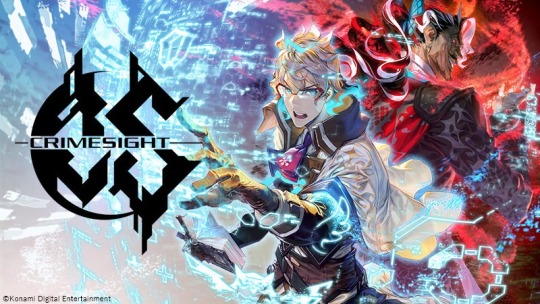
La editora Konami Digital Entertainment anunció que el servicio de CRIMESIGHT finalizará el 1 de mayo. Su página en la tienda de Steam será deslistada el 27 de febrero.
Aquí el comunicado:
“Gracias por haber jugado CRIMESIGHT.
El servicio ha seguido funcionando con el apoyo de muchos usuarios desde su lanzamiento en abril de 2022, pero debido a diversas circunstancias, hemos decidido dar por terminado el servicio el 1 de mayo a las 00:00 PDT.
Las ventas de paquetes finalizaron el 30 de enero de 2023 a las 00:00 PST. Las ventas de las ediciones Standard y Deluxe finalizarán el 27 de febrero a las 21:00 PST.
Las batallas en línea no estarán disponibles después de que finalice el servicio. Además, el juego en sí no podrá jugar. Aunque el tiempo que queda hasta el final del servicio es limitado, esperamos que lo disfruten hasta el final.”
youtube
0 notes
Text
YU-GI-OH! MASTER DUEL gets Major Update
YU-GI-OH! MASTER DUEL gets Major Update
Yu-Gi-Oh! MASTER DUEL got a major new update. This “content packed” update includes things like a new Solo Mode Gate, and Selection Pack as well as PVP multiplayer event, and more. Casual Mode was added on the 5th, and is part of this months update.
PRESS RELEASE
MAJOR UPDATE TO YU-GI-OH! MASTER DUEL INTRODUCES CASUAL MATCHES, DUELIST CUP, NEW CONTENT AND MORE
LOS ANGELES – August 9, 2022 –…
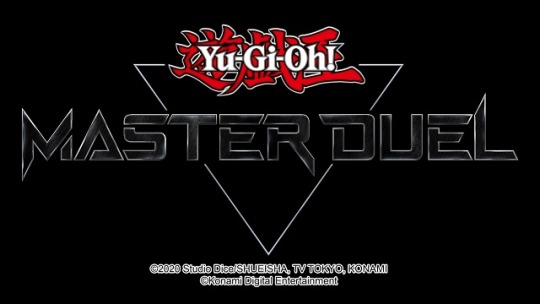
View On WordPress
0 notes
Text
I know that the past decade of website design should've been an indicator, but it's still pretty baffling that most of these tech innovators, leading the charge in media and entertainment, are also the biggest fucking dullards with ass-backwards thinking.
Why is VR so full of basic-bitch physic engine show-offs, or virtual grocery shopping, or shitty ports of first-person games? Where's the deluge of Yugioh knockoffs (or the real deal if Konami would get a fucking clue), or hell, maybe WotC could stop retarding themselves with D&D and MtG, and give us either in VR.
Also, why is fucking Zuckerbot making digital football, instead of getting the most derranged nerds to come up with crazy 'sports' that could only be accomplished digitally? Why aren't we getting goddamn anime-tier Beyblade matches, or some other insane activity enhanced by it not being limited by physical restraints?
So fucking stupid. VRChat's done more than any of these boring turdstains with their zillions of dollars and time to waste.
128 notes
·
View notes
Text

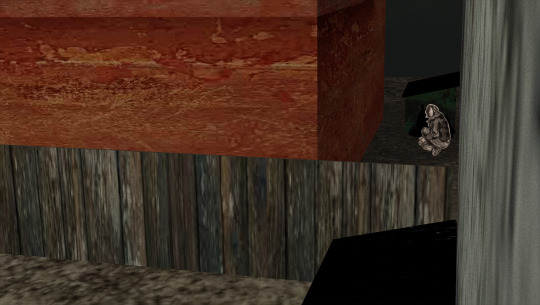




Yamaoka, Akira. “White Noiz.” SILENT HILL 2 (Original Soundtrack). Konami Digital Entertainment, 2001.
2024
18’ x 25”
Charcoal, newsprint, digital print on matte paper.
-
Siri play Serenity by Capcom Sound Team I need to dissolve into the jpeg floor.
I think it goes without saying but this piece was very heavily inspired by a love for older survival horror titles.
#art#digital art#my art#artist#charcoal#silent hill#ps2#blender#resident evil#silent hill 2#sh2#collage#traditional art#playstation#nostalgia
7 notes
·
View notes
Note
Do you have anything to say about metal gear: survive? It feels like you’d have some opinions on that

Oh, I most certainly do. As a matter of fact, I'll go off on a limb and say that there is a really good video on the subject which likely will hit more bases than I will in my own... "review," per se. (Granted, the video in question is a little lengthy, capping off at around 40 minutes, but if or when you have the time to, I would most certainly reccommend it.) And the video in question appears to void or ignore several instances which may have proven the creator's points wrong, BUT ALAS.
This is my opinion, not his, so here it is.
For those of you who might not know, Metal Gear: Survive, developed and published solely by Konami Digital Entertainment—and I'll try my best to describe it without sounding ironic or patronizing—was a little more-or-less a... "deviation," from the already-established base of the franchise, for more reasons than just one. However, the star aspect of the game in question which sticks out like a sore thumb above all the rest, would be the fact that you... fight zombies; the gist of the story following that of "the Captain, an MSF soldier who enters a parallel dimension and establishes a local command center to unravel the mysteries of a strange virus that turns people into zombie-like creatures."
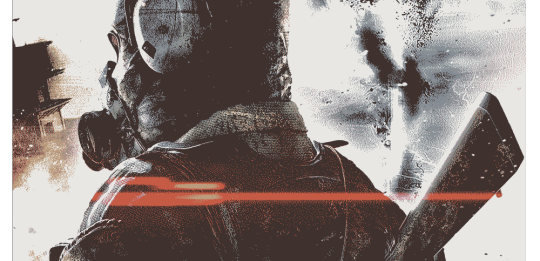
Which, yes, isn't an entirely foreign concept within the Metal Gear franchise at all; given the existence of the Skulls / Parasite Unit within Metal Gear Solid V: The Phantom Pain, joined with the vocal cord parasites, which—more or less—caused a similar, almost zombie-like effect within infected soldiers... however I believe that within that game—and every other Metal Gear game—such a presence of... idiosyncrasy, so to speak, was at least digestible without necessarily being overbearing. But, within a game like Metal Gear: Survive, it's the entire plot.
In essence, the game was quite similar to the likes of Bloons: Tower Defense, perhaps Clash of Clans... but instead of popping balloons, you're bursting blood vessels at the mere thought of not only having to micromanage platforms and... "survive", but at the cost of having to sit through a near-infuriating, almost comically disconnected story which is so far separated from the source material, that you wonder to yourself; "Is it true that Kojima greenlit such a thing?"
The answer towards which would be: no, he didn't, and even touted its existence in the very same fashion, alongside Yoji Shinkawa, who stated that, "If [he] were to have worked on Metal Gear: Survive, there most certainly would have been mechs [present within the game.]," to paraphrase. Predictably, all of this was entirely out of Kojima's hands—for reasons I'm sure we're all aware of—and thus... inevitably resulted in being a massive mess. Despite its... mixed reception.
Would this game have been better as a standalone, far separated from the Metal Gear franchise in its entirety? Perhaps... but seeing how this game appears to have been created for the sole purpose of... "milking the Metal Gear cashcow"—given how eager Konami Digital Entertainment was to resume production of its Pachinko machines, mobile games... already having brought into consideration throwing Metal Gear into the mix, even before all of this mess occurred—I find that to be highly unlikely, given how this game wasn't necessarily made with... good intentions.
Even aside from its messy production, and the entire... "Kojima v. Konami" debacle, I find that the game's artistic and programming design absolutely, positively pale in comparison to Metal Gear games of old. Which could likely easily be explained by Metal Gear concept artist Yoji Shinkawa's absence in said game's creation... however I find that the game pales in almost every category, not just in regards to its visual design. Even if, that too, is a little...


Like... I don't even know what to say, or how to describe this, in complete honesty. And with little-to-no valuable information upon this... creature's Wikia page, much less within the game itself, it seems it would be inconsequential to just pass this off as a hiccup on Konami's behalf. And while this game is non-canonical, and a spinoff, it just... it makes no sense, at least within a Metal Gear-centric context. As well as a visual aspect, and from a conceptual aspect. Both in theory and in execution, apparently.
This, alongside its music and sound design, I find to be appalling and almost shameful, because... even if you've never touched or seen anything out of this game, nor have you desired to so much as poke it with a ten-foot-pole, you can just tell that its music is completely soulless. As evident by the lack of Metal Gear Solid V: The Phantom Pain's primary composer, Ludvig Forssell, alongside several other musicians and composers which have come together over the years of Metal Gear's conception to carefully craft many masterful and memorable pieces we've all come to know and love.
If I asked you to compare these two soundtracks, blindly, which one would you prefer? If I were to give no other description, other than "ALBUM #1" and "ALBUM #2," in your honest opinion, which do you truthfully believe you would fancy better?
ALBUM #1?
Or ALBUM #2?
I'm not so sure about you, but without a shadow of a doubt, I would choose the first album. With the conception of Metal Gear Solid V: The Phantom Pain's music, near-instantly could I pick apart not only rhythms and patterns within Mr. Forssell's writing, but trademarks, of which are near-impossible to miss. I cannot say the same for the music of Metal Gear: Survive; all of which sounds too corporate and generic to have even a fragment of soul within it. As evident between the difference of "Ludvig Forssell," and "FILM SCORE LLC," present beneath each of either album's tracks on Spotify.
Because, as we all know, a very important factor of a video game's irrefutable success is its music; its memorability, its notoriety... being able to hear even a single set of notes from a piece, which near-instantly causes you to point at your radio or device screen and exclaim, "Hey! I know that song!" A very good example of such musical genius being—despite my vices against its base—Metal Gear Rising: Revengeance. And even if you've only ever listened to a single song from that game, you'll know that it KICKS ASS, even if you've never once played the game in your entire life. A sort of general consensus that all of the game's "fans" can agree upon.
But, I suppose, at the end of the day, even bad games have their fans, just as horrible, irredeemable villains have their fans. And even if I were to never touch Metal Gear: Survive with a ten-foot-pole, there are people who find it to be entertaining; viewing its punishing gameplay design as a sort of plus, in a way. And, if you were to play the game without thinking too hard about its associations or deeper themes, I would agree with that sentiment. Sometimes, just playing a game to play a game is the better route to take.
And even if that game is nothing more than a cheap grapple with relevancy, all the while remaining false to its home series's pretexts, then by all means: be my guest. Just don't expect me to make a post—as long as this one is—praising the game for anything.
#text#essay#rambles#ask#rant#anonymous#metal gear#metal gear survive#mgs#metal gear solid#mgsv#metal gear solid v the phantom pain#we love corporate greed /s#art stuff#music#(Sorry this took so long Anon!)
8 notes
·
View notes
Text
Game Spotlight #7: Snatcher (1994)

Acquired Stardust's next game spotlight is here! This time Ash takes a look back at the first title in Hideo Kojima's portfolio that one would probably call a 'Kojima game' in the Sega CD port of Konami's Snatcher, a traditional Japanese-style adventure game, with an examination of some of the history and culture around its American release!
Popular wisdom recalls that the ESRB was founded in 1994 in response to the moral panic surrounding the earlier 1992 release of Mortal Kombat, but this collective memory is missing a few details - namely that it wasn't Mortal Kombat alone that created the panic. It was a trio of games, all released in 1992, that caused the mainstream American culture to pay attention to the medium, which had begun to enter its edgy teenage phase, and it did not like what it saw.
Sega CD classic Night Trap was one of the most prominent releases in the then-popular Full Motion Video field, essentially an interactive campy d-tier horror movie that tasked players with protecting the residents of a house besieged by bumbling, uncoordinated creepers with the timely use of trap doors via security camera operation. It was vaguely sort of voyeuristic in the way that likely titillated the senses of teenagers in 1994 before widespread access to the internet, but otherwise mostly unremarkable and had little redeeming qualities. Konami's own Lethal Enforcers was the third game in the trio, a fairly standard arcade shooter featuring a realistic revolver-type handgun for players to use as a controller along with Mortal Kombat style digitized actors for its visuals.
Long before Columbine at the end of the decade, these three games were singled out as essentially the harbinger of the doom of a generation of American youths, allegedly promoting violence and sexual assault against women, prompting a series of US senate hearings the following year best summed up by Democratic senator from Wisconsin Herb Kohl's stern warning on the industry needing to reign itself in: "If you don't do something about it, we will".
It's certainly true that the video game industry had begun to experiment with new, different and edgier games that would increase in their edginess in the years to come (Duke Nukem for example was released a mere 3 years after the senate hearings), but it was abundantly clear to anyone who was paying attention (and indeed anyone with a brain) that this was largely a shallow echo of the ongoing satanic panic which had the country collectively clutching its pearls since the 1980s. Night Trap was certainly not endorsing sexual violence against women (and its content was far more tame than was asserted even by the standards of 1993), and Lethal Enforcers was simply a very standard arcade shooter following the digitized graphical trend with a realistic (though brightly-colored) peripheral. However, the industry responded to the hearings in relatively short order with the creation of the ESRB (that's the Entertainment Software Ratings Board) in September of 1994, meant to advise consumers on the content of the video games they were buying in an effort to help police the perceived wild moral decay corrupting America's youth. It was somehow in this climate that Konami decided that it was time to bring Hideo Kojima's PC-88 adventure game Snatcher (originally released in Japan in 1988) to the west for the first time with an upgraded port.
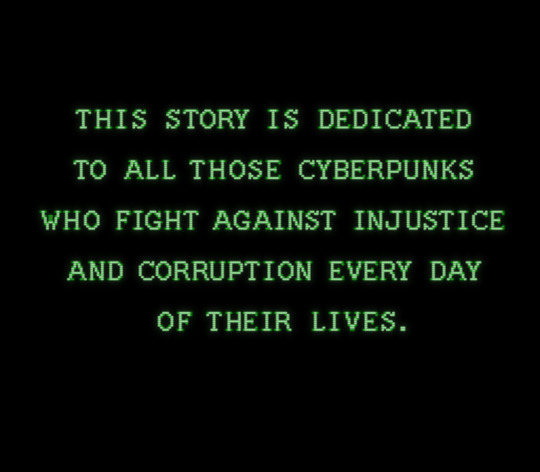
While the video game scene in America had begun to show signs of maturing into its teenage years, Japan had at this point a well known pop culture machine churning out plenty of violent and sexual content (not without its own local controversy I might add), and was no stranger to content not meant for children. Typically when an American thinks of Japanese adventure games they think of Capcom's popular later Ace Attorney series, and might consider Snatcher the direct predecessor of it, but the genre has a very long history on Japanese PCs with a large number of games, often of a pornographic nature, released. It's a chapter of gaming history that is poorly preserved, particularly in the west (where it is often unknown that Enix, famous for its Dragon Quest series, started with releases of erotic adventure games in 1983), but is an important link between the two games.
Particularly foundational for the Japanese adventure game genre was 1983's Portopia Serial Murders, a game by future Dragon Quest creator Yuuji Horii, responsible for popularizing the interface and style of virtually every game in the genre to follow. Of particular note it was a young Hideo Kojima, future creator of the Metal Gear franchise, who took heavy inspiration from Portopia, seeing the adventure game genre and their cinematic nature as his pathway into doing the next best thing to what he'd always wanted to do: creating movies. And so Snatcher was born.

Snatcher is set in the fictional Neo Kobe city, a cyberpunk dystopia heavily inspired by Blade Runner, and while the video game industry may have been maturing into its teenage years, it is incredibly striking how adult Snatcher immediately comes across. Opening with a fully-voiced narration about a catastrophic Russian biohazard that killed 80% of the populace preceding the appearance of what are essentially Blade Runner's replicants (the titular snatchers), main character Gillian Seed bids farewell to the wife he recently underwent a separation with and sets off to join Neo Kobe's JUNKERs, a special police force tasked with hunting down and eliminating snatchers.
Snatcher stands head and shoulders above its contemporaries in not just the content of its story but the sophistication with which it is told. It boggles the mind that Sonic the Hedgehog 3 and Donkey Kong Country, incredible games in their own right, are some of the big mainstream releases of 1994 while this was also on store shelves. Immediately obvious through its incredible opening cinematic is a hallmark of creator/writer/director Hideo Kojima's titles all the way to the present day: they are incredibly dense and feature an almost overwhelming level of worldbuilding. Arriving at JUNKER headquarters only hammers the point home, with the player able to research a number of in-world historical topics that play out across multiple lengthy encyclopedia entries. While it is not necessary to fully explore these (the player does receive a few answers to later characters' questions in two entries), it goes a very long way to making the world feel very real which is an effect that the game achieves very well out of the gate with its flawed protagonist picking up the pieces and attempting to rebuild his life after a failed marriage with or without his former wife, itself a very realistic struggle that many can relate to. Another hallmark of Hideo Kojima titles is present in the form of abundant easter eggs and meta humor, with just one example of such easter eggs being that the player can use a phone obtained early in the game to call one Taeko Hayasaka (then a spokeswoman for Konami) as well as the localization director Jeremy Blaustein and receive some special dialogue.

Playing out across three acts, the player follows Gillian's investigation into the snatcher crisis gripping Neo Kobe city which threatens to spill over into the world at large all while grappling with his own amnesia stemming from a mysterious incident before the start of the game. It's worth noting that another hallmark of Kojima video games was present in the original 1988 release of Snatcher in the form of deadlines cutting his project into dramatically shorter form, where a planned six acts was cut to a mere two. Ending on a severe cliffhanger up until this generation of ports where the final third act was added in an attempt to wrap up the ongoing storyline as best as possible, the third act was somewhat controversial at the time due to its linearity in comparison with the rest of the game which is rather open in its accommodation of player sidetracking.
Though toned down in its Sega CD port to the west, Snatcher features a very surprising level of gore and sexuality (all while somehow only achieving a rating of T for teen from the ESRB) that can catch people even today unprepared for it. A clearly defiant Konami takes several shots in-game at the then-current moral panic around video games and the senate hearings that resulted in the creation of the ESRB, and it's hard to deny that had the game received more contemporary attention that it probably would've been hugely controversial in the mainstream for its violence and sexual content (much of which is based around the absurdity of being able to investigate people you meet, leading to everyone from JUNKER chief Cunningham to daughter of fellow JUNKER Katrina thinking you're an unhinged lunatic). The game does have a reputation for allowing the player to behave in a creepy manner towards female characters, itself an oft-criticized element of Hideo Kojima's works, and while that is true in some respects I found it of particular note that Gillian is able to 'investigate' every single character in the game regardless of gender (much to their dismay) and that not only is this never actually required to progress in the game, there are instances where being creepy towards female characters can result in the player being actively punished. Just because Gillian can doesn't mean that he should - a good lesson to all you people struggling with self-control out there.
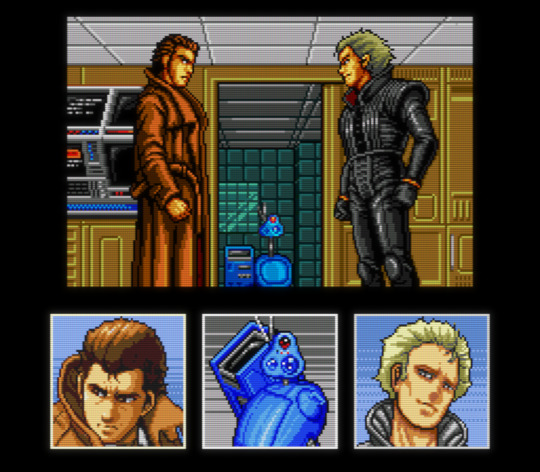
All the things one typically associates with a Hideo Kojima title are present in Snatcher, including heavy inspiration from cinema, self-referential elements such as Gillian partnering with a very familiar robot sidekick appropriately named Metal Gear, to dense narratives told with an astounding level of worldbuilding and flavor, all through the style of using familiar concepts such as a setting very inspired by Blade Runner to get its foot in the door before making a hard left turn into original wonderful sci-fi insanity that culminates in what can only be described as 'a very Hideo Kojima' third act, and if you're familiar with his work you likely know exactly what that means.
The graphics and storytelling are excellent, featuring some incredible writing and localization for the time. Thanks to the Sega CD's disc-based nature the game boasts very good quality music and even a shocking level of voice work which is also similarly surprisingly high quality for a release from 1994 (though there are a few lines which fall flat), as many wouldn't consider the golden age of English voiceover dubs to start for another several years. Extremely ahead of its time in a year when we were still playing as giant gorillas jumping on crocodiles, the incredibly intricate story of Gillian Seed won't be something I forget and has held up remarkably well, serving as a great early example of the depth of experiences that gaming would come to host, particularly in the indie game scene which produces experiences often very relatable and impactful to players with a similar 'art from the artist' vibe.

In a time where the industry was beginning to reflect the sensibilities of a teenager, Snatcher largely feels very adult and manages to impress with its content and sophistication even to the present day. Hideo Kojima's freshman effort laid the groundwork for an incredible portfolio of titles and is worth experiencing for anyone who are fans of Japanese-style adventure games, visual novels, cyberpunk, or just plain good stuff.
A gem hidden among the stones, Snatcher is undoubtedly stardust.
--Ash
#video games#acquired stardust#game spotlights#gaming#retro gaming#sega#sega cd#konami#hideo kojima#snatcher#1994#1988#cyberpunk#blade runner#ash#visual novel#adventure games#retro games#Metal Gear
17 notes
·
View notes
Text
Completed x2 - Castlevania: Symphony of the Night (Sega Saturn version)
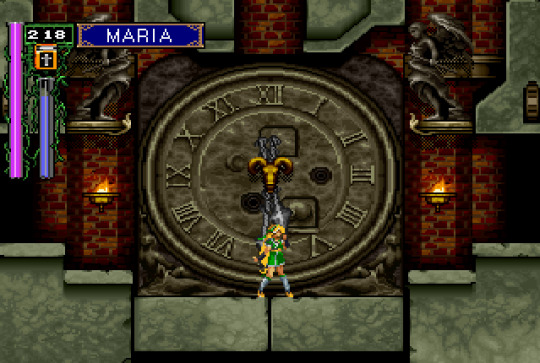
Madness may be doing the same thing over and over again, but hey. At least I'm having fun doing it.
If economics were indicative of what my favorite video game of all time is, "Castlevania: Symphony of the Night" would win bar none. Just off of the top of my head, this is how many times I've made purchases of this title alone:
US PlayStation Copy - $6.00 (disc only from a now defunct GameStop location in 2006, so don't get too optimistic)
Japanese PlayStation Copy - $38.00
PSP Copy of "Dracula X Chronicles" (contains a unique SOTN variant) - ~$40.00
PS3 Digital Copy - ~$5.00
Xbox Live Digital Copy – Free (promotional; probably was a tie-in to "Bloodstained: Ritual of the Night" being released)
Additional copies for friends - ~$5.00
US PlayStation Copy for my sister - $50.00
Sega Saturn Copy - $140.00 (2016 in Akihabara; keep the date/place in mind)
This probably isn't even the sickest I could be in collecting copies of this game. Hell, I've been hung over at a stranger's house with access to their Xbox 360 and thought about purchasing it there as well just so I could distract myself from being sick.
For this particular situation, we're going to talk about the Sega Saturn variant of "Castlevania: Symphony of the Night." While I had heard about this one before, I hadn't thought about hunting it down. Content differences aside, I didn't have a Sega Saturn, nor has the Sega Saturn emulation scene been particularly stellar. But, on the one time (and hopefully not last time) @jeannettegray and I were physically in the same place, she happened to find this in the retro game store we were in. At first, I protested. It'd be irresponsible to buy something like that, right? And then I caved because, as established above, I'm kind of a bitch (submissive) for this game.
Fast forward to 2023. I've gotten into the anime series "Lupin the Third" (again, thanks JG!) I've been accumulating some "Lupin" games because they're fairly uncontested in the grand scheme of video game hunting. Considering that at least one is a staple on the bad/weird video game tournament Kusogrande, that should tell you about how well they normally go. But, I did happen to watch a match for the Lupin the Third game "Sage of Pyramid," which seemed to be generally well received! So, I found a copy of it on eBay in a three-pack with two other "Lupin" archive titles. To make a long story short, I ended up with a Japanese Sega Saturn, plus a few extra games.
I know. Between this and the Nintendo Wii U purchases this year, you've really got to ask what's wrong with me.
"Castlevania: Symphony of the Night" is a title I have previously reviewed, so I’m not going to bang too much about the shared properties here. Game good; game great; game arguably one of the best games ever made. The Sega Saturn port occurred about one year after the original PlayStation release by Konami Computer Entertainment Nagoya (KCEN), a branch office (and notably, not the original developer pool from KCET.) While KCEN mostly made either portable versions of console-based Konami games or movie-licensed games, KCEN is notable in "Castlevania" development for both this and "Castlevania Legends," the GameBoy title with female lead Sonia Belmont. Which means that they:
Chugged women-respecting juice like water.
Got everything they did chucked into a historical/narrative paper shredder.
Given this development, the Sega Saturn version of "Symphony of the Night" is in a weird place. It has more content—particularly, in additions to Maria Renard's presence and playability—but is often looked down as an inferior product. In particular, some of the most ridiculed items include load times, transparency implementation/workaround issues, and sprite quality. And boy, did I see some actual, verifiable hardware issues. But, despite that, I do think this variant has some serious charm to it. At least, I'd be way more likely to come back to this version than the PSP version.
Look, if I buy a Sony PSP, you have the right to hit me…up for donations for a charity.
Before we can talk about this game, I think we need to talk about the Sega Saturn itself. Like, the poor bastard only seemed to have success in Japan. (Being $100.00 more expensive than its competitor will do that to you.) It was the kind of non-successful entity that when I heard the Nerve Tower recommending the Sega Saturn version of "Baroque" above all other versions of the game, I felt nothing but mockery for the sentiment. My opinion on the console changed somewhat after tending to a minor memory issue for the console. See, with old consoles or games dying, I'm used to having to buy oddball components and then getting help from my dad in resoldering them into place. With the Sega Saturn? It was simple as buying a new CR2032 battery (from a Wal-Mart! Imagine that) and just popping it into place.
Let's just say I have a lot of appreciation for a console that is easy to manage.
Now, if it were as easy to program as it was to fix, I doubt the Sega Saturn would have floundered as much as it did. I haven't done a great, deep deal of reading into coding for this console, but it seems like working with it required a great deal more knowledge than just popping in some C++ and plugging away. I suppose comparing programming for the Sega Saturn and Sony PlayStation is somewhat like the difference in operating a racecar versus an average sedan. In the right environments and with the right skill level, the former will out-perform the latter. But, at the end of the day, whatever is easiest to handle and cheapest to purchase will be used by more people.
Granted, "Symphony of the Night" should have been a natural slot-in for the Sega Saturn's library. While its best-selling titles were in 3D, a significant chunk of its library contains 2D sprite-based fighters. Weirdly enough, "Symphony of the Night" could qualify for this with its visual presentation and its control style. It's just…well…from what I can tell, this was KCEN's second and last Sega Saturn title. I don't think the experience or confidence was here for a perfect port. Hell, even notes from the developers themselves are frequently lamenting development delays.
Also—Yoshinori Suzuki is the realest for having a reference to Goblin music in his note. I'm more team Suspiria when it comes to Goblin music, but I have full faith that band could slay a "Castlevania" composition.
Okay. Enough sympathy for the devil! Let's get down to the game itself.
The objectives for this port of "Symphony of the Night" match up to the original base game. If you've got SOTN down 200.6% elsewhere, you'll easily hit 210% here. Does the math not add up? Well, it never really did. But, in this case, the first noticeable change is the addition of two new areas per map side. These new areas are respectively dungeon and garden-flavored, both of which make sense in terms of an addition. Neither add a great deal of room content to the game (capping at about 6 rooms for the garden and 3 for the dungeon), but they do provide some benefits, including:
A bridge piece between the Marble Gallery and Underground Caverns
New enemy types
A new boss fight
Access to the Alucard Spear (which, granted, is more important for Lecarde family lore than anything. But it's nice to pick up!)
These areas (and the castle's entrance) also sport some new tunes. Okay, maybe just "Chaconne C Moll" and "Guardian" are wholly originally. But, it does contain pairs of dance and jazz mixes for the "Vampire Killer," "Bloody Tears," and "Beginning" themes. Sure, they're the most 90s-sounding compositions on this planet. But, goddamn if that isn't exactly what I wanted from a "Castlevania" game.
I know. Real trash-core behavior on my part. At least give the "Beginning" remixes a shot before you take another one at me.
Item distribution and placement has also been slightly tweaked from the base PlayStation game, although it is generally in the player's favor. (For example: the Sword familiar is just below the save room of Orlox's Quarters instead of being in a hidden ceiling space.) About the greatest addition of note here is a cape called the Rainbow Robe, which cycles through palettes to create a constant color swapping effect. Very cool. There are also some different familiars than what is present in the US PlayStation version of the game, but about all that is unique there is getting a Half-Faerie that sings if you get her some lyrics. Which…thanks? I guess?
Honestly, the big content augment to the game is Maria Renard. Not only does she become a boss for Alucard to fight (having him prove his strength to her), but she's also playable! And holy shit, does she kick ass! Like, she generally kicks ass, but my God. Literal ass kicking here! Kicked my ass as a boss. Kicked everyone else's ass when fighting them in her mode. I'm not kidding when I say that only three bosses posed a threat to me while playing her. (For those of you that want to attempt this playstyle: it was Orlox, the "Castlevania III" trio, and Galamoth that gave me the most trouble.) If you've got Alucard's Dark Metamorphosis and Soul Steal input commands down, congratulations. You can absolutely slaughter the game as Maria.
It's wild. In her mode, she's got:
A chargeable magic attack as her primary attack
A triple and high jump
An evasive somersault (while Alucard doesn't even have a slide mechanic, so LMAO)
A base kick attack (for when you're storing up magic)
Access to standard "Castlevania" subweapons
Combo commands for summoning all four Celestial Beasts whenever you've got the MP (granting on-the-go healing, two massively damaging attacks, and a limited-time familiar)
A variety of martial arts attacks, and
Access to a full invincibility-granting move! (Like, you've gotta do a full clockwise input + a charge to do it, so it does require some serious skill to use. But still!)
Talk about a power fantasy! Like, no wonder people talk about the reset to Maria's move pool in the PSP version of "Symphony of the Night" being a downgrade. She's an absolute beast here.
Begrudgingly, I can see why Maria's abilities were augmented in later releases. To some extent, I think the IGA team was trying to keep in lockstep with the "Rondo of Blood" version of her, especially considering that the PSP game is primarily a remake and re-release of that game. And, okay, yes. She was originally designed as a tiny Belmont alternative. But in the Sega Saturn SOTN version? With her input pool and abilities? She's an Alucard alternative. Hell, her heal move maps to one of his recovery abilities (Genbu to Dark Metamorphosis), and her primary devastating spell is also the homewrecker in his (Seiryuu to Soul Steal.) She wasn't designed out of nowhere. She was just pulled from a different man's ribs.
I guess if nothing else, the PSP sprites of her are prettier. So…there's that.
Oh! Prettiness. Guess that leads back to the overall aesthetic quality of the game (or potentially lack thereof, depending on who you ask.) Personally, the biggest issues I had here were not so much with sprite distortion, but with load and lag. This game doesn't have the same load-in grace going between new areas or loading in boss fights as the PlayStation version does. It seems like it struggles greatest with particle effects, although bosses with multiple chunks and entities to them can also cause severe rendering delays. Hoo boy, does it not like a bunch of stuff on screen all at once! The Beelzebub and Legion fights in particular bring out the greatest lag in the system, so be prepared for that when/if you tackle them. Even Galamoth has some lag (although, I was using that to my benefit when possible.)
In terms of transparency compensation, the Saturn version does well enough to skirt around some issues. The trailing movement sprites are still following you, so A+ there. Some magic spells were altered to use white instead of using transparency, which honestly? I thought that made some look very pretty (Tetra Spirit in particular!) About the only place I could point at and scold was the hidden cavern behind the waterfall in the Underground Caverns section. In the PlayStation version, it is smoothly revealed as the player steps into it. In the Saturn version? It's like someone flicked a light switch on. Honestly, it would have just been better to let the player always see it, if that's what revealing it was going to look like.
Also, killing Fire Demons is particularly ugly in this game. It's just a lazy, nonsensical sprite swap (as opposed to the color cycling in the PlayStation version.) The Marionette deaths are pretty funny, though!
There was one point where the lack of full implementation actually impressed me. Anti-spoiler at this point, but the final boss fight with Dracula has a much different feeling in the Saturn version. Not that the move cycles he has have even remotely changed. It's the background! In the PlayStation version, it's a bit psychedelic—maybe more like something you'd see in an "Earthbound" or "Star Fox" ending fight. In the Saturn version? 100% black. Cheap? Sure. But, considering Alucard is fighting his father in a realm between the living and the dead—in a complete abyss—it honestly grew on me. Like, yeah, ha ha! The devs couldn't figure out how to do the funky color/texture cycling! But also? Absolute darkness works, too.
I would be remiss if I didn't mention the bodily injuries I'm currently nursing post playthroughs as well. Like, my left thumb was taking some abuse from the default controller's D-pad, so I ended up playing through portions of Maria Mode using an HSS-0104 Virtua Stick. (Like I said—I spent some stupid money on this console.) I just ended up pushing the injuries from my thumb to my shoulder blades. 😅 I can't completely blame the game on that, though. I should know better than to do 8+ hours of gaming in a day.
By the way—I did confirm something switching controllers. It seems like this "Symphony of the Night" variant likes to pick up on Up button presses more than in the PlayStation version regardless of the controller used. At least, I was pulling the Fireball / Byakko spells more than intended. I also found myself thinking less in terms of hitting every button in a combo, instead just smearing into cardinal directions. Like, the Saturn seems to have more of a slide detection to it than I anticipated? It's the difference from going down + down-forward + forward to down and forward while smushing your thumb up. You just kinda go legato, not giving a thought about the intermediate inputs.
Okay, verdict time!
Did I enjoy the Sega Saturn port of "Castlevania: Symphony of the Night?" Absolutely! While it has its oddities, I hesitate to call this product inferior. It's definitely not as tight of an experience as the standard PlayStation version, but what is here is cool. I would put this in the same category as "Castlevania: Dawn of Sorrow" in that if you can't vibe with the main game for some ridiculous reason, it's got awesome side-modes to back it up.
Would I recommend other people play this game? Of course!
Would I recommend other people buy this game?
Look. I know when I'm being ridiculous. This experience personally cost me somewhere between $300.00 to $350.00 USD. Like, what the fuck. Madness! It would have been worse, had I actually bought this game this year! I mean, as of writing, this game, complete in box, is trending at $219.15 USD on PriceCharting.com! Shit, I might as well tell you to buy an arcade cabinet for how ridiculous this could get! And then you've got to weigh the pros and cons of taking systems out of their native countries, what international buyers are doing to the Japanese video game market, the risks of transporting stuff that far, and so on. It's not something you can just say, "LMAO, do it!" about.
But, what I will say is that BizHawk has a pretty good Sega Saturn emulator. And also, I might have written some documentation on how to get BizHawk set-up for Sega Saturn emulation. Chances are you're smart enough to figure out the rest.
10 notes
·
View notes
Text
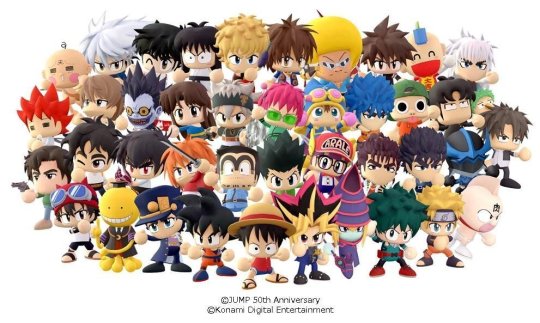
5 years ago today, Weekly Shonen Jump Jikkyou Janjan Stadium was originally released on iOS and Android only at JP. It was distributed by Konami Digital Entertainment.
#fighting games#fighting game#weekly shonen jump jikkyou janjan stadium#weekly shonen jump#wsj#ios#android#konami
12 notes
·
View notes
Text
Konami: 55th Anniversary Teaser | Thursday, 03.14.24
Next week, legendary video game developer and publisher, Konami will celebrate its 55th anniversary.

#konami#konami animation#konami code#video game nostalgia#video game news#55th anniversary#since 1969#video games#video game developer#video game publisher#anime studios#march#march 1969#march 2024#march 14#konami group corporation#konami digital entertainment#コナミ#throwback thursday#thursday teaser#thursday thoughts#video game companies#logo
1 note
·
View note
Photo




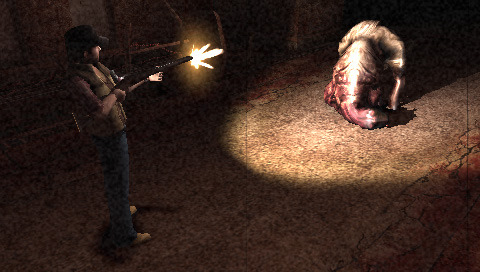


Silent Hill Origins (2007)
Silent Hill: Origins (Silent Hill Zero in Japan) is a 2007 survival horror game developed by Climax Action and published by Konami Digital Entertainment. It was released worldwide in late 2007 for the PlayStation Portable and later got a PS2 port.
The fifth installment in the Silent Hill series, Origins is a prequel to the original Silent Hill (1999). Set in the series' eponymous, fictional American town, Origins follows trucker Travis Grady as he searches for information about a girl whom he rescued from a fire. Along the way, he unlocks his repressed childhood memories.
#silent hill#silent hill origins#silent hill 2#silent hill 3#silent hill 4#silent hill 4 the room#silent hill zero#silent hill 0#silenthillorigins#silenthill0#silenthillzero#konami digital entertainment#climax action#psp#psp game#playstation portable#ps2#ps2 game#ps2 games#psychological horror#psychological#psychological horror game#horror genre#horror games#horror game#survival horror#Classic Horror#Old Horror#old horror game#old horror games
68 notes
·
View notes
Text
Metal Gear Titans: Tactical Onslaught
We bring you an MGS x AOT crossover, in which Big Boss leaves Outer Heaven and travels to Paradis, to give Eren a Meta upgrade before the assault on Marley.
No copyright intended, music belongs to Sony Entertainment & Konami Digital
#anime#gaming#playstation#metal gear solid#big boss#solid snake#attack on titan#eren yeager#eren jaeger#manga#crossover#digital art
3 notes
·
View notes
Text
So, as you may or may not have heard, SEVENS World has been confirmed for Duel Links!
This was announced at the Yu-Gi-Oh! World Championship. Here's the video. The announcement's at 1:37:11. It should jump right to the timestamp, if i've done this correctly. (it's not just the logo showing up. there's an actual announcement afterwards.)
youtube
Here's a transcript of the full message given by Akitsu Terashima (or at least, what the English subtitles say.)
⁂
"Hello everyone! I am Akitsu Terashima, Producer for the 'Yu-Gi-Oh! Digital Game' Development team at Konami Digital Entertainment.
The history of Yu-Gi-Oh! DUEL LINKS began with the Yu-Gi-Oh! Duel Monsters world in 2016.
Thanks to all the Duelists around the world, we were able to release the world of Yu-Gi-Oh! VRAINS last year, the sixth Yu-Gi-Oh! anime series in DUEL LINKS.
We believe more and more Duelists have been enjoying the game through the various worlds of the Yu-Gi-Oh! series.
We are currently preparing to bring a new world to DUEL LINKS on September 28th, and this would be based on the seventh anime series, Yu-Gi-Oh! SEVENS.
This means that Yu-Gi-Oh! RUSH DUEL, which has been available since 2020 for TCG players in Japan, will be available to all in Yu-Gi-Oh! DUEL LINKS!
With rules that allow them to draw multiple cards at once and Summon monsters back-to-back, Duelists are sure to enjoy this new and exciting fast-paced version of Dueling with RUSH DUEL.
We are hoping that this update to Yu-Gi-Oh! DUEL LINKS becomes an entry point for players to enter the exiting world of Yu-Gi-Oh!
Once the Yu-Gi-Oh! SEVENS world is released, both 'SPEED DUEL' and 'RUSH DUEL' will be playable in-game.
We hope both 'SPEED DUEL' and 'RUSH DUEL' will be enjoyed by everyone all over the world. Please look forward to the next big update in Yu-Gi-Oh! DUEL LINKS.
Thank you!"
7 notes
·
View notes
Text
3 notes
·
View notes